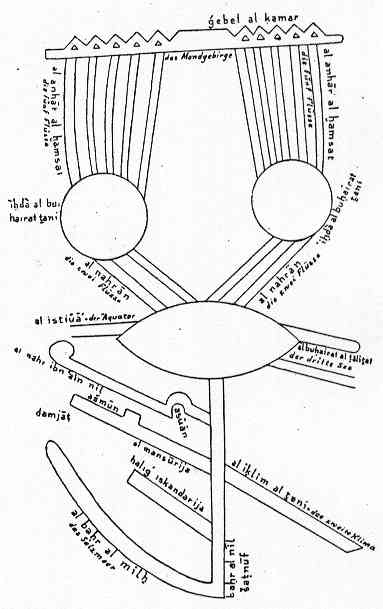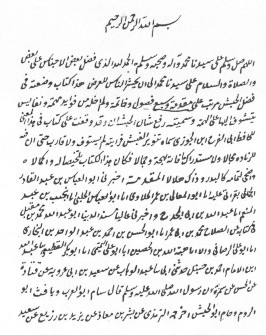Suyuti (1445-d1505): Every paragraph comes out of a different book. From Cairo
--------------------------------------------------
Taken from : Journal asiatique 1837 (for the first paragraph, the other paragraphs; out of many different sources none of them translations of his work)
Full name: Abd al-Rahman ibn Kamal al-Din Abi Bakr ibn Muhammad ibn Sabiq al-Din, Jalal al-Din al-Misri al-Suyuti al-Shafi`i al-Ash`ari, also known as Ibn al-Asyuti
He was the mujtahid imam and renewer of the tenth Islamic century, foremost hadith master, jurist, Sufi, philologist, and historian, he authored works in virtually every Islamic science.
His name is spelled in at least 10 different ways on the Internet. He wrote 560 books, 723 according to others.

Ahmed ben-Joussouf al-Tifachi teaches us that (the mountains of the moon) stretch east to west and that they becoming smaller get lost in the vast deserts who stretch from both sites. In the middle of this mountain chain, the eye finds, according to him, enormous sand plains, and the dunes are sometimes quiet big.
Azz-addin ben-Djomast, gives us some details on the sources of the Nile that are useful to describe here. From mount al-Qomr leave ten rivers, of which five go into a big circular lake and five in another one also circular. These two lakes are situated at 7 deg 31' southern latitude, and the one farthest east at 57 deg longitude. These lakes are the origin of four rivers who reunite all separately in a little round lake, situated in the first climate, at 53deg 30' longitude and 2 deg latitude north. From this last lake then leaves the Nile of Egypt. The river passes then through the country of Noubah where it is joint by a big river (bleu Nile)
According to Azz-eddin ben-Djomaat the mountains are situated at 11 deg 30' south of the equator and stretch for 15 deg 20'.
One of his works is called:
al-Mutawakkili fima warada fi al-Qur'an bi al-lugha al-Habashiyya wa al-Farisiyya wa al-Rumiyya wa al-Hindiyya wa al-Siryaniyya wa al-`Ibraniyya wa al-Nabatiyya wa al-Qibtiyya wa al-Turkiyya wa al-Zanjiyya wa al-Barbariyya ("My reliance concerning what has been mentioned in the Qur'an in Ethiopian, Farsi, Greek, Hindi, Syriac, Hebrew, Nabatean, Coptic, Turkic, Zanj-language, and Berber")
Mutawakkili is the Caliph who commanded that he compiled a list of Quranic words that are to be found in the speech of the Ethiopians, Persians, or any people other then the Arab. In it he lists 108 words from 11 languages. It is organized according to language and for each language in textual order of the Quran. He made also a similar list in an other book of his with 124 foreign words, and a third is in his : al-Itqan fi 'ulum al-Quran which for different reasons is mentioned here too. Suyuti did not get into linguistic research himself, he copied what was written on the subject in former centuries.
Taken from: Bell, William, Yancy;The Mutawakkili of as-Suyuti
The report of what appears (in the Quran) in the language of the Blacks (Zanj)
(Hasb Jahannam)
Ibn Abi Hatim, on the authority of Abdallah Ibn Abbas, concerning God's expression, hasab jahannam it means fuel for Gehenna in the language of the Blacks (Zanj).
(Al Minsaa)
Ibn al-Jauzi related that al-minsaa means staff in the language of the Blacks (Zanj).

Taken from: Akbar Muhammad; The image of Africans in Arabic Literature.
From his Raf al Hubsan
Praise be to Allah Who preferred some people to others.....I composed this treatise on the virtues of the Ethiopians .....and I did not exclude from it the important instruction (fawa'id) and gems (which) the eager enquirer needs.....I read a treatise on this subject by .... Ibn al-Jawzi entitled Tanwir al Ghabash. But I found It lacking and incomplete. Indeed, there is scope for more (information) and the addition of the beautiful (details) that eluded him. This is an abridgement of and a supplement to his treatise. Due to its completeness it shines like a full moon compared with that (of Ibn al-Jawzi which is like) a crescent.
The contents of the work (in 110 chapters):
1. On the Traditions Concerning Them (Ethiopians)
2. On the revealed (Quranic) Verses about Them.
3. On Quranic Terms of Ethiopian (Geez) Origin.
4. On the Emigration to Ethiopia, the Emigrants, the Conversion of Amr b. al-As and the Negus Betrothal of Umm Habiba to the Prophet....
5. On some (35) prominent (good, pious) Ethiopian Personages. (important here are the najashi = Ethiopian emperor and Bilal)
6. On the Peculiarities and Good Qualities Which They Possess
7. Some previously considered Matters.(examples; the reason of the rising of the Nile in Egypt is heavy rain in the land of al-habasha and also Egypt will be destroyed due to drying up of the Nile and also Mecca will be destroyed by the Ethiopians)
8. Epilogue: concerning the Desirability of marrying Concubines and the fear of Abandoning (i.e., not marrying) virtuous slaves.
An extract out of this book:
Taken from; G. Rotter; Die stellung des negers in der islamisch-arabischen gesellschaft
A large number of authors wrote over the preferences of white ones over brown ones. Ibn al-Matzuban putted himself in contrast to these, by writing a book concerning the black ones and their advantages over the white ones. But I need to give probably hardly attention to this work, since the same wrote also a book concerning the advantages of the dogs before many, who wear dresses. If he already places the dogs over humans, then it does not mean anything, if he prefers the black ones to the white ones. Al-Hafiz al-Mundiri reports in his Tarikh: Two men argued about the preference/advantage between the white ones and black ones, on which Abu' l-Abbas at Nasi wrote a Risala (discussion) over the advantages of the black ones over the white ones. That sees normal for him, who also wrote of Musahara (in-laws) between glass and gold.
He wrote also a book called : Azhar al'Urush fi Akhbar al-Hubush (The flowers of the throne concerning information about the Ethiopians)
And also from his : Nuzhat al-'Umr fi'l-tafdil bayna'l-Bid wa'l-Sud wa'l Sumr
part of which concerning the attractions of black women.
A number of men of letters wrote comparisons of light- and brown-skinned peoples. Ibn al Marzuban wrote Kitab al-Sudan wa Fadluhum'ala al-Bidan (The book concerning the dark skinned people and their preference over light skinned peoples). I do not think that is strange of him, for indeed he wrote Kitab Tafdil al-Kilab ala Kathir mimman Labisa al-Thiyab (The book of preference for dogs to many who wear clothes). So if he preferred dogs to people, is it not strange that he would prefer dark skinned people to light skinned peoples. Al-Hafiz al-Mandhari said in his history: Two man disputed over the merits of light skinned and dark skinned peoples; so Abu al-Abbas al-Nashi wrote Risala fi Tafdil al-Sud ala al Bid (An essay on the preference for dark skinned peoples over light skinned peoples). In my opinion, this is like the person who proudly wrote ( a work comparing) gold to glass. This is a nice comprehensive treatise on what has been stated regarding preference for light-,dark-and brown-skinned people, it is entitled; the Promenade of a Lifetime.
And also : Mustazraf min akhbar al-jawari : The graceful reports concerning women slaves
From his : Tafsir ul-Jalalain (or Jalaluddin), commentary on the Koran, begun by Jalfll ud-Din ul-Maljalli (1389-1459) and finished by Suyuti Commentary on the following part of the 18th chapter of the Koran:
Then he continued his way, until he came to the place where the sun riseth; and he found it to rise on certain people, unto whom we had not given anything wherewith to shelter themselves therefrom. Thus it was; and we comprehended with our knowledge the forces which were with him. And he prosecuted his journey from south to north.
The Jalaluddin of Suyuti says they were the Zanj, a black nation lying south-west of Ethiopia. They seem to be the Troglodytes of the ancients
In his : Azhar al-Mutanathira fi al-Ahadith al-Mutawatira (The Most Prominent of the Reports Concerning the Narrations of Mass Transmission) his own version of the curse of Ham appears; it starts with : Ham looked shamelessly at his father when the man was bathing.